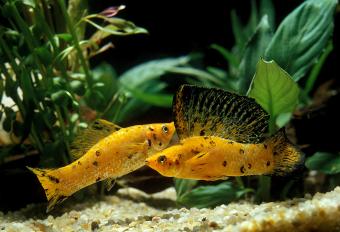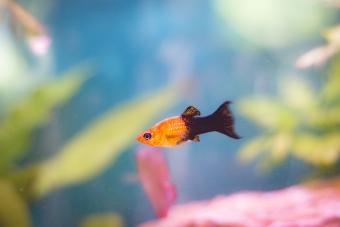
Some of the most popular aquarium fish are livebearers. This means they give birth to their young live rather than laying eggs and waiting for them to hatch. These babies are known as fry.
Guppies
One of the most beloved aquarium fish for both beginning and experienced hobbyists is the guppy. Fancy guppies come in a wide range of colors, patterns and tail and fin styles. They are small fish with females reaching one-and-a-half to two-and-a-quarter inches and males reaching one to one-and-a-half inches in length. They are relatively easy to care for and are a perfect choice for owners who want to learn how to breed fish. Guppy lovers come to enjoy their fish so much that many branch out into breeding them for show and developing new strains of these lovely fish.
Guppy Gestation and Fry
Female guppies will gestate their young for about 22 to 26 days. Guppies can give birth to anywhere from two to 200 fry at a time.
Mollies
Another popular fish is the Molly because of their ease of care. Like guppies, they come in many colors and patterns but they can be larger with both males and females reaching up to four inches in length. They are generally peaceful fish although some can be more aggressive than others.
Molly Gestation and Fry
Mollies usually gestate their young for about four weeks. At birth they can have as few as 12 fry, especially if she's a new mother. Mollies can give birth to as many as 80 fry at a time.
Platies
Platies or platys are another easily obtained fish that is a good beginner choice. They are peaceful, come in many colors and are active small fish. They can even breed with another livebearer, the swordtail, if they live in a community tank together.
Platy Gestation and Fry
Platies tend to gestate their young for about four to six weeks. They can have approximately 80 fry during a normal birth.
Swordtails
The swordtail is named for the shape of their tails and they are a close relative of platies. These fish come in a wide array of colors and can do well in tanks with other fish as they're considered peaceful. Males, however, can be more aggressive than females, especially toward other males. Swordtails are also the largest of the livebearer fish, with males reaching about four inches in length. They can also jump and require a tank with a secure lid.
Swordtail Gestation and Fry
Swordtail females gestate their young for about 28 days. Like other livebearers, the swordtail can produce up to 80 fry at one time.
Endler's Livebearer
Sometimes also called Endler guppies, these fish are very similar to guppies in terms of their care and breeding. They can even mate with guppies although any fry they produce will be sterile. Females are about one to one-and-a-half inches long and males are three-quarters to one inch. Endler's livebearers are a bit different from other livebearers in that they are not likely to eat their fry.
Endler's Livebearer Gestation and Fry
An Endler's livebearer female will gestate their young for about 22 to 24 days. A typical batch of fry will be about 15 in number, although it can be as little as 5 fry or as many as 25.
Two Types of Livebearers
There are two general types of livebearer fish: ovoviviparous and viviparous.
- An ovoviviparous fish has eggs that develop while not receiving any nutrients from their mother, or in some cases father if the male fish carries the fertilized eggs.
- A viviparous fish is different in that the eggs are nourished by the blood of the parent, similar to how humans are gestated in the womb.
Most of the commonly found livebearer fish in aquariums are ovoviviparous including guppies, platies, mollies, swordtails and the Endler's livebearer.
Livebearer Fish Families
There are four families of fish that are livebearers:
- Poeciliidae or live-bearing toothcarp includes guppies, mollies, platies, swordtails and mosquito fish. This family includes almost 200 different species. The poecillidae are the most commonly found livebearer fish found in aquariums.
- Goodeidae includes splitfins and Mexican topminnows. There are about 40 species in this family.
- Anablepidae includes the "four-eyed fish" with a total of 16 different species.
- Hemiramphidae includes the live-bearing halfbeaks of which there are about 100 different species.
Caring for Livebearer Fish
Most livebearer fish found in pet and fish specialty stores are easy to care for and are known for being adaptable to water condition variations. If at least one male and one female is in a tank together, you will not need to do much to get them to breed and they can breed and produce fry often. In fact, it's wise to keep more females than males as one male may pursue a single female over and over and cause undue stress.
Females and Superfetation
Because these fish breed so often it is not unusual to purchase a female livebearer who is already pregnant. In fact, due to a process known as superfetation, many female livebearers can store sperm from the male for months at a time. They can use this stored sperm to give birth to several sets of fry over the course of a few months.
Caring for Livebearer Fry
Each species will produce different amounts and sizes of fry but they all have in common the need to protect the fry once born.
- A female fish can eat her fry once she's given birth. You will need to keep her in a separate area of the tank using a breeding net or a small separated birthing area.
- Once the female gives birth, she can be returned to the main tank.
- The fry should be kept separately in a heated tank until they're large enough to swim safely in the main tank, especially if it's a community tank with many types of fish who consider them a snack.
- It's best to use a foam filter in the nursery tank which can prevent the tiny baby fry from getting caught.
- Provide lots of vegetation and hiding places for the fry. Plants can be artificial or live and look for ones that are spread out with lots of hiding spots. Fry tend to hang out at the top of the tank so floating plants are a good choice.
- Once the fry are large enough, you can return them to the main tank. Usually this is after four to six weeks and when the fry is clearly too large for the mouths of the other fish.
Feeding Livebearer Fry
Livebearer fry should be fed a few times a day for the first four to six weeks. You can feed them food that is made for fry such as frozen or live baby brine shrimp, baby fish pellets or flakes, or adult fish flakes that you grind down into smaller pieces.
Enjoying Livebearer Fish Care
While it may seem like a lot of work, caring for and breeding popular livebearer fish is actually not difficult. Many beginning fish enthusiasts get their start with fish species like guppies and mollies and become quickly entranced by this new hobby. As long as you understand how livebearer fish give birth and the importance of protecting the newly born fry, you can have many years enjoying these beautiful and fascinating fish.







